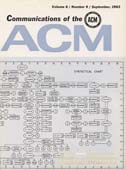September 1963 - Vol. 6 No. 9

Features
A formula for numerical integration is prepared, which involves an exponential term. This formula is compared to two standard integration methods, and it is shown that for a large class of differential equations, the exponential formula has superior stability properties for large step sizes. Thus this formula may be used with a large step size to decrease the total computing time for a solution significantly, particularly in those engineering problems where high accuracy is not needed.
Some computer operating systems have a bad habit of inserting tape marks into the output stream willy-nilly. This often results in loss of output when a tape is scratched after its first file has been printed. Other operating systems, notably those recently distributed by IBM for use with the 7090, put tape marks on print tapes only on command, so that frequently a print tape is removed from the computer without any tape mark, and extraneous material is printed.
M. L. Pei [Comm. ACM 5, 10 (Oct. 1962)] gave an explicit inverse for a matrix of the form M + &dgr;I, where M is an n-square matrix of ones and &dgr; is a nonzero parameter. The eigenvalues of the Pei matrix were given by W. S. LaSor [Comm. ACM 6, 3 (Mar. 1963)]. The eigenvectors may be obtained by considering the system (M+&dgrI)x = &lgr;x, the jth equation of which is S + &dgr;xj = &lgr;xj , (1) where S denotes ∑ni=1 xi. On summing the equations for j = 1, 2, ··· , n, we obtain nS + &dgr;S = &lgr;S. From this we conclude that (a) S = 0 or (b) &lgr; = n + &dgr;.
A semi-iterative process for evaluating arctangents
The technique of obtaining arctangents by inverse interpolation [1] is a relatively long process not suitable for a subroutine. The Taylor series expansion for arguments less than unity converges rather slowly for those near unity. The method of small increments of the argument [2] is again inconvenient for a subroutine. A more rapid series expansion in terms of Chebyshev polynomial [3] is given in terms of a new argument, which is less than 0.1989. This method requires the storage of &pgr;, √2 - 1 and seven coefficients and is perhaps widely used. However, for multiple precision not only the coefficients have to be evaluated to the precision desired, but more must be used. Therefore the following alternative method may prove to be convenient and efficient.
A list processing system in which each list cell contains both a forward and a backward link as well as a datum is described. This system is intended for imbedding in higher level languages capable of calling functions and subroutines coded in machine language. The presentation is in the form of FORTRAN programs depending on only a limited set of “primitive” machine language subroutines which are also defined. Finally, a set of field, particularly character, manipulation primitives are given to round out the system.
MIRFAC: a compiler based on standard mathematical notation and plain English
A pilot version of the compiler MIRFAC, now in the operation, is described. The chief features of the system, which is intended for the solution of scientific problems, are the presentation of mathematical formulas entirely in standard textbook notation. The use of plain English for organizational instructions, automatic error diagnosis indicating the actual location of the error in the uncompiled program, and an attempt to minimize that fragmentation of the original problem statement which is a normal feature of programming systems.
To meet the need for improved documentation of written computer programs, a simple system for effective communication is presented, which has shown great promise. The programmer describes his program in a simple format, and the computer prepares flow charts and other cross-referenced listings from this input. The description can be kept up-to-date easily, and the final output clearly explains the original program. The system has also proved to be a valuable debugging and coding aid.
On the approximate solution of Δ u=F(u)
Three-dimensional Dirichlet problems for &Dgr;u = F(u), Fu ≧ 0, are treated numerically by an exceptionally fast, exceptionally accurate numerical method. Programming details, numerous examples and mathematical theory are supplied. Extension of the method in a natural way to n-dimensional problems is indicated by means of a 4-dimensional example.
A general program for the analysis of square and rectanglar lattice designs
This paper describes a general-purpose program that will handle those incomplete block designs known as square and rectangular lattices. Flow diagrams are given so that the method of calculation may be programmed for any digital computer.
Group participation computer demonstration
Engelbart1 has reported on some demonstrations in which a group functions as various parts of a digital computer. These demonstrations are concerned with binary operations including addition. However, there are occasions when it is desirable to have a group participate in a simulation which is not at this detailed level of computer operation. This note suggests a demonstration which allows a group to simulate the execution of a computer routine itself.



